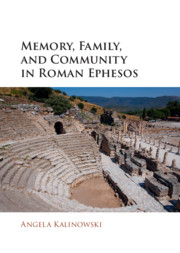Book contents
- Memory, Family, and Community in Roman Ephesos
- Memory, Family, and Community in Roman Ephesos
- Copyright page
- Dedication
- Contents
- Figures
- Maps
- Tables
- Acknowledgments
- Abbreviations
- Introduction: Memory, Family, and Community in Roman Ephesos
- 1 Community, Identity, and Memory in Roman Ephesos
- 2 The Vedii: A Family’s History in Ephesos
- 3 “Great is Artemis of the Ephesians!” The Vedii and the Goddess of Ephesos
- 4 Fun and Games in Roman Ephesos: The Vedii, the Agonistic Festivals, and the Imperial Cult
- 5 The Vedii and the Associations of Ephesos
- 6 The Vedii and Their Civic Buildings in Ephesos
- Conclusions The Vedii: A Family’s Place in the Community and in the Commemorative Landscape of Ephesos
- Appendix Who’s Who among the Ephesian Vedii and Flavii Vedii
- Bibliography
- Subject Index
- Index of Inscriptions
3 - “Great is Artemis of the Ephesians!” The Vedii and the Goddess of Ephesos
Published online by Cambridge University Press: 06 July 2021
- Memory, Family, and Community in Roman Ephesos
- Memory, Family, and Community in Roman Ephesos
- Copyright page
- Dedication
- Contents
- Figures
- Maps
- Tables
- Acknowledgments
- Abbreviations
- Introduction: Memory, Family, and Community in Roman Ephesos
- 1 Community, Identity, and Memory in Roman Ephesos
- 2 The Vedii: A Family’s History in Ephesos
- 3 “Great is Artemis of the Ephesians!” The Vedii and the Goddess of Ephesos
- 4 Fun and Games in Roman Ephesos: The Vedii, the Agonistic Festivals, and the Imperial Cult
- 5 The Vedii and the Associations of Ephesos
- 6 The Vedii and Their Civic Buildings in Ephesos
- Conclusions The Vedii: A Family’s Place in the Community and in the Commemorative Landscape of Ephesos
- Appendix Who’s Who among the Ephesian Vedii and Flavii Vedii
- Bibliography
- Subject Index
- Index of Inscriptions
Summary
This chapter examines the roles of the Vedii in the cult of Artemis, Ephesos' premier goddess. Members of the family were priestesses, prytaneis, kouretes, and festival presidents. In the late second century they gave major material gifts to the goddess: the so-called stoa of Damianus, which I argue was actually paid for by his wife, Vedia Phaedrina, a dining hall in the Artemision, and an inheritance. These gifts to Artemis show that the cult of Artemis was alive and well in late second century Ephesos. Furthermore, supporting the cult of the goddess in various ways allowed the members of the family to publicly demonstrate their devotion to the city's protectress, and to gratify their fellow citizens with festivals, banquets, and buildings.
Keywords
- Type
- Chapter
- Information
- Memory, Family, and Community in Roman Ephesos , pp. 91 - 172Publisher: Cambridge University PressPrint publication year: 2021

